Sound Systems:
Mono versus Stereo
| MouseOver - Single channel versus two channel loudspeaker coverage
Compare the single channel centre |
It is very apparent that everyone has their own interpretation of the terms 'mono' and 'stereo', influenced by their own experiences and expectations. Translating one's experience with home audio systems or project studios into a large venue like a church or a theatre often takes an adjustment in conceptual thinking, so we always have to provide a reference point for the discussion of mono, stereo and two channel sound systems. Let's start off with mono.
Mono
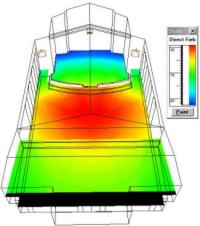 Mono or monophonic describes a system where all the audio signals are mixed together and routed through a single audio channel. Mono systems can have multiple loudspeakers, and even multiple widely separated loudspeakers. The key is that the signal contains no level and arrival time/phase information that would replicate or simulate directional cues. Common types of mono systems include single channel centre clusters, mono split cluster systems, and distributed loudspeaker systems with and without architectural delays. Mono systems can still be full-bandwidth and full-fidelity and are able to reinforce both voice and music effectively. The big advantage to mono is that everyone hears the very same signal, and, in properly designed systems, all listeners would hear the system at essentially the same sound level. This makes well-designed mono systems very well suited for speech reinforcement as they can provide excellent speech intelligibility.
Mono or monophonic describes a system where all the audio signals are mixed together and routed through a single audio channel. Mono systems can have multiple loudspeakers, and even multiple widely separated loudspeakers. The key is that the signal contains no level and arrival time/phase information that would replicate or simulate directional cues. Common types of mono systems include single channel centre clusters, mono split cluster systems, and distributed loudspeaker systems with and without architectural delays. Mono systems can still be full-bandwidth and full-fidelity and are able to reinforce both voice and music effectively. The big advantage to mono is that everyone hears the very same signal, and, in properly designed systems, all listeners would hear the system at essentially the same sound level. This makes well-designed mono systems very well suited for speech reinforcement as they can provide excellent speech intelligibility.
Stereo
True stereophonic sound systems have two independent audio signal channels, and the signals that are reproduced have a specific level and phase relationship to each other so that when played back through a suitable reproduction system, there will be an apparent image of the original sound source. Stereo would be a requirement if there is a need to replicate the aural perspective and localization of instruments on a stage or platform, a very common requirement in performing arts centres.
This also means that a mono signal that is panned somewhere between the two channels does not have the requisite phase information to be a true stereophonic signal, although there can be a level difference between the two channels that simulates a position difference, this is a simulation only. That's a discussion that could warrant a couple of web pages all by itself.
An additional requirement of the stereo playback system is that the entire listening area must have equal coverage of both the left and right channels, at essentially equal levels. This is why your home stereo system has a "sweet spot" between the two loudspeakers, where the level differences and arrival time differences are small enough that the stereo image and localization are both maintained. This sweet spot is limited to a fairly small area between the two loudspeakers and when a listener is outside that area, the image collapses and only one or the other channel is heard. Living with this sweet spot in your living room may be OK, since you can put your couch there, but in a larger venue, like a church sanctuary or theatre auditorium, that sweet spot might only include 1/3 the audience, leaving 2/3 of the audience wondering why they only hear half the program.
In addition a stereo playback system must have the correct absolute phase response input to output for both channels. This means that a signal with a positive pressure waveform at the input to the system must have the same positive pressure waveform at the output of the system. So a drum, for instance, when struck produces a positive pressure waveform at the microphone and should produce a positive pressure waveform in the listening room. If you don't believe that this makes a tremendous difference, try reversing the polarity of both your hifi loudspeakers some day and listening to a source that has a strong centre sound image like a solo voice. When the absolute polarity is flipped the wrong way, you won't find a stable centre channel image, it will wander around away from the centre, localizing out at both the loudspeakers.
Two Channel
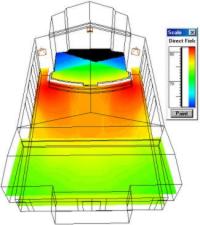 This is what many people mistake for stereo sound systems, because there are two channels and a "stereo" console is connected to the front of the system, and stereo amplifiers and equalizers are used throughout the system. What is missing from most of these systems is uniform coverage of the entire listening area, and a minimal level and phase response difference for each channel's coverage of the listening area. To achieve proper loudspeaker coverage to replicate a stereo image in a large venue, it is necessary to have a loudspeaker system for each channel that can provide uniform coverage of the entire listening area while maintaining the directional cues. This is a very expensive, and sometimes impossible proposition.
This is what many people mistake for stereo sound systems, because there are two channels and a "stereo" console is connected to the front of the system, and stereo amplifiers and equalizers are used throughout the system. What is missing from most of these systems is uniform coverage of the entire listening area, and a minimal level and phase response difference for each channel's coverage of the listening area. To achieve proper loudspeaker coverage to replicate a stereo image in a large venue, it is necessary to have a loudspeaker system for each channel that can provide uniform coverage of the entire listening area while maintaining the directional cues. This is a very expensive, and sometimes impossible proposition.
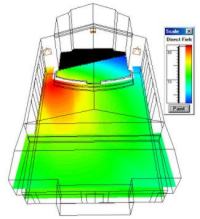 Two channel systems usually suffer from having half the people in the listening area only hear half the audio program, which makes two channel systems a poor choice for music reinforcement. A large portion of the listeners hear a completely different music mix from other listeners. This is an all-too-common oversight in venues that are intended for music and entertainment, even high profile venues where they deserve better system designs. It tends to be a common misconception brought forward by people with a background in portable or live sound systems.
Two channel systems usually suffer from having half the people in the listening area only hear half the audio program, which makes two channel systems a poor choice for music reinforcement. A large portion of the listeners hear a completely different music mix from other listeners. This is an all-too-common oversight in venues that are intended for music and entertainment, even high profile venues where they deserve better system designs. It tends to be a common misconception brought forward by people with a background in portable or live sound systems.
When a two channel system is used to reinforce a mono voice microphone, the seats either side of the room centreline, exactly between the two loudspeakers, also experience substantial variations in frequency response and uniformity of coverage due to interference and signal cancellation when identical signals arrive from the two channels at different times. This makes two channel systems especially ineffectual for speech reinforcement applications.
Left/Centre/Right
There are specialized applications for sound systems described as Left/Centre/Right configurations. This must combine the best of both worlds, right? Well it can, but the loudspeaker system must also be designed to the highest common denominator not the lowest. It is also important with an LCR system that the mix engineer understand which signals must be routed to which loudspeakers, and which signal routings will create problems. LCR systems also are not suitable for use in all room shapes and configurations.
LCR systems are common in drama theatres and large churches where there is a requirement for both mono speech reinforcement and music or sound effects cues to be localized or mixed with a particular perspective, with a stereo or stereo-like imaging. The three loudspeaker systems must each provide coverage of the entire seating area while maintaining level and directional cues, just like the mono and stereo systems described above. There are some clever "cheats" a system designer can use to achieve the extended listening area for stereo coverage, and that invloves using "stingers" or infill loudspeakers.
Stingers
As shown above in the MouseOver demo, a stinger is a speaker positioned to provide coverage of a floor area that may be inaccessible from the left or right cluster mounting position.
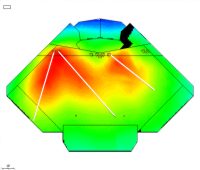 In the example above, the left and right stingers are separate from the centre cluster, and would be fed from a signal delay so that for people in the right side of the room, the signal from the left stinger would arrive at the same time as the sound from the left cluster would have if it could have reached that location. For people sitting near the front right, they would still hear the program from the left channel to maintain the integrity of the program content, even though the stereo image would be skewed to one side compared to the image perceived by the people sitting in the middle of the room. The speaker selection, as well as the level and delay setting of the stingers are all quite critical to their successful integration, if they are too loud, too late or too early they will detract from the image the rest of the audience hears. If you're going to try this at home study up on Haas Effect, setting levels and delays for precedence, as well as time domain measurement systems.
In the example above, the left and right stingers are separate from the centre cluster, and would be fed from a signal delay so that for people in the right side of the room, the signal from the left stinger would arrive at the same time as the sound from the left cluster would have if it could have reached that location. For people sitting near the front right, they would still hear the program from the left channel to maintain the integrity of the program content, even though the stereo image would be skewed to one side compared to the image perceived by the people sitting in the middle of the room. The speaker selection, as well as the level and delay setting of the stingers are all quite critical to their successful integration, if they are too loud, too late or too early they will detract from the image the rest of the audience hears. If you're going to try this at home study up on Haas Effect, setting levels and delays for precedence, as well as time domain measurement systems.
It is also possible to use some of the components of the centre cluster as the stingers, especially with the advent of lower cost DSP systems that allow a matrix of signal delays to be developed for each input to the unit. Even a few years ago this would have been exceedingly expensive and complicated (and nearly impossible to explain), now it can be programmed quickly on a computer screen and be made to work quickly and easily. This approach works best when the centre cluster has similar sounding loudspeaker components to the left/right clusters.
Which one's the best?
As with many questions about sound systems, there is no one right answer. A well designed mono system will satisfy more people than a poorly designed or implemented two channel sound system. The important thing to keep in mind is that the best loudspeaker design for any facility is the one that will work effectively within the, programmatic, architectural and acoustical constraints of the room, and that means (to paraphrase the Rolling Stones) "You can't always get the system that you want, but you find some times that you get the system that you need." If the facility design (or budget) won't support an effective stereo playback or reinforcement system, then it is important that the sound system be designed to be as effective as possible, even if that means giving up a desirable program requirement like stereo.
For those of you looking for more info about mono and stereo recording, try Wikipedia.
Surround sound
Dual channel双声道/Stereo立体声/Joint stereo联合立体声 区别
Dual channel:由两个单声道组成,两个声道编码时不考虑相关性,每个声道的码率为音频总码率的一半。E.g in a 128kbits file each channesl woudle take 64kbits。
Stereo:由两个或多个相互独立的声道组成,每个声道的码率根据其各自编码信息量大小而定。人耳听到时能对音源位置进行定位。E.G right use 48kbits and left uses 96 kbits in a 128kbits file。不会计算双声道之间的资料相关性,但是会协调分配双声道的资料流量,自动分配较多的 Bit 给复杂的声道使用。
Joint stereo:也是由两个声道组成,但编码时兼顾了这两个声道的共同信息量,比Stereo的压缩率更高。在这个压缩模式下,LAME 会利用双声道之间的资料相关性进行演算。左右声道资料类似时,会利用 M/S (Mid/Side) 编码技术,计算中央声道 (L+R) 和两侧声道差异 (L-R) 的值,并且会分配较多的 Bit 给中央声道,增加资料记录频宽。
单、双声道指的是音频处理系统电路是1、2套。立体声指的是音源。最基本的立体声要求两个发音器件,使得发出的声音被人耳听到后产生立体感。
实现立体声就要求播放器至少具有双声道,音源左右声道分别馈入双声道放大电路最终通过扬声器播放出来。
音频数字化是将连续的模拟声音波形数字化,主要包括采样频率、采样数位/采样精度两方面,二者决定了数字化音频的质量。反映音频数字化质量的另一个重要因素是声道个数。记录声音时,如果每次生成一个声波数据,称为单声道;每次生成二个声波数据,称为立体声(即双声道),立体声能够更真实反映人的听觉感受。
立体声不等于双声道,通俗的介绍应该是立体声一定由双声道组成,但是双声道不一定是立体声,因为立体声是根据双耳效应原理进行录制的,如果一个单声道音源分为两个声道也不能称为立体声,立体声的特点是能够对声音进行左右定位。
在放声系统中,应用两个或两个以上的声音通道,使听者所感到的声源相对空间位置能接近实际声源的相对空间位置,这种重放声音称为立体声。立体声有双声道立体声、四声道立体声、杜比立体声、杜比环绕声、杜比AC-3数码环绕声等。
Joint Stereo是一种立体声编码技巧,主要分为Intensity Stereo(IS)和Mid/Side (M/S) stereo两种。IS的是在比较低流量时使用,利用了人耳对於低频讯号指向性分辨能力的不足,将音讯资料中的低频分解出来合成单声道资料,剩余的高频资料则合成另一个单声道资料,并另外纪录高频资料的位置资讯,来重建立体声的效果。例如钢琴独奏的录音就可以利用这种方法在有限的资料流量中减少音场资讯却大幅增加音色资讯。
Mid/Side (M/S) stereo在左右声道资料相似度大时常被用到,纪录方式是将左右声道音讯合并(L+R)得到新的一轨,再将左右声道音讯相减(L-R)得到另外一轨,然后再将这两轨资料用上面提到听觉心理学模型与滤波器处理。Mid/Side (M/S) stereo与IS一样的是利用部分相位(phase)资讯的损失来换得较高的音色纪录资讯。一般的MP3是Mid/Side stereo和Intensity Stereo交替使用的,视资料内容与流量而定。如果是更高流量如160kbps以上的MP3,则可以单独将立体声的两个声道独立编码,以保存相位资讯。
如果你经常自己动手制作 MP3 的话,那你可能遇到过“单声道(Mono)”、“联合立体声(Joint Stereo)”、“立体声(Stereo)”之类的名词。它们是不同的音频声道模式,其中“单声道”和“立体声”大家都比较熟悉了,那么这个“联合立体声”到底是什么呢?它和“立体声”又有什么区别呢?
经过查证和思考,本人得出以下结论,仅供参考。
“联合立体声模式”是音频编码的立体声模式之一。联合立体声模式充分利用左右声道的相似之处,对于左右声道的相同部分不再重复编码,减少了数据的浪费,这样就可以做到在较低的位率下表现更丰富的细节。对于左右声道差异不大的音频来说,联合立体声编码模式通常在较低的位率下就可以得到不错的效果。
而“立体声模式”则使用两个相互独立的声道进行编码,因此它需要较多的位率,但它的左右声道的分离度较高,通常使用在位率较高的场合,用于高质量的音频编码。
根据经验,在制作一般的 MP3 歌曲时,使用 128 kbit/s 的位率和联合立体声模式比较合适。这里再附上一篇英文资料:
Q : What's the difference between the various stereo modes?
A : It's important to understand the difference between Stereo and Joint Stereo. 'Joint Stereo' modes take advantage of the similarities between the L+R channels. This allows more bits to be used in other areas and in many cases this can give an overall gain in encoding quality. Almost all encoders use joint stereo when encoding at 128 kbits.
Joint stereo has 2 submodes called IS and MS. 'Joint Stereo IS' destroys phase information and shouldn't be used for high-quality encoding. 'Joint Stereo MS' means Middle/Side and is OK for use in most encoding.
However, for some audio, Joint Stereo MS may create a 'flanging' or
'swishing' effect. In these cases it's better to use 'Stereo mode'. This mode creates 2 independent channels for both left and right. When stereo mode is used, you should also use a higher bitrate (160 or 192 kbits) - Stereo mode will allocate about half of this bitrate for each channel.
In summary, for most audio, Joint Stereo MS at 128 or 160 kbits should be fine. If your audio is especially 'wide' and creates flange you should use 'Stereo' mode. You can change these modes in the Radium codec control panel.





 本文深入探讨了联合立体声与立体声的区别,解释了这两种音频编码方式的工作原理和应用场景,帮助读者理解如何根据需求选择合适的音频格式。
本文深入探讨了联合立体声与立体声的区别,解释了这两种音频编码方式的工作原理和应用场景,帮助读者理解如何根据需求选择合适的音频格式。
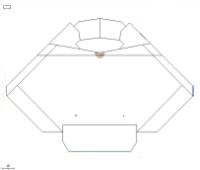
















 5576
5576

 被折叠的 条评论
为什么被折叠?
被折叠的 条评论
为什么被折叠?








